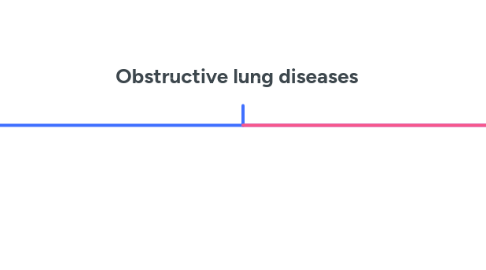
1. COPD
1.1. Chronic bronchitis
1.1.1. Defined clinically as a productive cough occurring for at least 3 months per year over at least 2 consecutive years. - Characterized by excessive mucus production in the airways. -The main cause of COPD in developed countries is tobacco smoking. COPD often occurs in people exposed to fumes from burning fuel.
1.1.1.1. Pathophysiology : 1) Proliferation and hypertrophy of bronchial mucous glands. 2) It also damages cilia, impeding mucus clearance. 3) There is also airway inflammation.
1.1.1.1.1. The obstruction to airflow in chronic bronchitis is in the terminal bronchioles, which is proximal to the obstruction in emphysema. The symptoms and signs: Shortness of breath, wheezing, chest tightness, frequent respiratory infections , chronic cough that may produce mucus ( sputum) , cyanosis and edema has led to the label “blue bloater”
1.2. Emphysema
1.2.1. Definition: Emphysema is abnormal and permanent airway enlargement distal to the terminal bronchiole, accompanied by progressive destruction of alveolar walls and surrounding interstitium. The result is loss of elastic recoil, dilation of the terminal air spaces, and air trapping.
1.2.1.1. Pathophysiology. Emphysema develops from either excess elastase (smoking) or deficient α1-antitrypsin (genetic) production which leads to progressive destruction of alveolar walls. Increase elastase (from inflammatory cells) that digests elastin (the component responsible for elastic recoil of alveolar walls). α1-Antitrypsin is an enzyme that neutralizes elastase, thus maintaining the elastic properties of alveolar walls.
1.2.1.1.1. Clinical presentation of emphysema Patient age over 50 except in α1-antitrypsin deficiency Dyspnea. Cough with scanty sputum production. Barrel-shaped chest Hyperresonance on percussion The patient’s face is puffy and red
1.2.1.1.2. Complications of emphysema 1. Respiratory failure. 2. Cor pulmonale (pulmonary hypertension and right side heart failure). 3. Pneumothorax
2. Asthma
2.1. Reversible obstructive disease characterized by hyperreactive and hyper responsive airways that lead to bronchoconstriction with minimal irritation. Asthma is frequently seen in patients with a family history of eczema and allergic rhinitis.
2.1.1. Symptoms: Shortness of breath Chest tightness or pain Wheezing when exhaling, which is a common sign of asthma in children Coughing or wheezing attacks that are worsened by a respiratory virus, such as a cold or the flu
2.1.1.1. Types of bronchial asthma:
2.1.1.1.1. Extrinsic asthma: Mediated by a type I hypersensitivity reaction involving IgE and mast cells . Often begins in childhood in patients with a family history of allergies. Common allergens include animal dander (especially cats), pollen, mold, and dust mites.
2.1.1.1.2. Intrinsic asthma: Due to nonallergic causes. Precipitating factors include viral, exercise, cold temperatures, air pollutants (eg, cigarette smoke), stress, and medications (especially aspirin). Due to hyperactive vagal nerve endings no increasein IgE.
2.1.1.2. Pathophysiology. 1) Airway inflammation leads to bronchial hyper-responsiveness. 2) Associated with this inflammation; eosinophils, lymphocytes, histamine, leukotrienes, and IgE. 3) Inflammation leads to airway smooth muscle contraction (bronchospasm) and secretions within the lumen. 4) Unlike COPD, the process in asthma is generally reversible, so between attacks, most asthmatics have relatively normal physiology.
2.1.1.2.1. Pathology, Edema of the bronchial walls with smooth muscle hypertrophy Cellular infiltrates (eosinophils and lymphocytes). Denuded epithelium, enlarged mucous glands , and increased number of goblet cells .Curschmann spirals (whorled mucus plugs) containing shed epithelial cells. Eosinophilic crystals Charcot-Leyden crystals composed of eosinophil protein galectin- 10 found in people who have allergic diseases
3. Bronchiectasis
3.1. Definition: Bronchiectasis is irreversible dilation of the airways caused by repeated episodes of infection and/or inflammation with eventual destruction of the bronchi and bronchiole walls.
3.1.1. Pathophysiology Repeated infection and inflammation lead to destruction of the bronchi and bronchiole walls. Over time, as the airways lose their elastic recoil, they become unable to expel air. As a result, air is functionally trapped in the lungs. This allows bacterial colonization, pooling of secretions, and additional inflammation, forming a vicious cycle.
3.1.1.1. Clinical presentation: Severe persistent cough with expectoration of mucopurulent sometimes foul smelling or bloody sputum. The cough is paroxysmal in nature especially in the morning or on changing the position due to draining of the accumulated purulent secretions.
3.1.1.1.1. Microscopic Picture: The bronchi are dilated and the bronchial epithelium may show ulceration. The bronchial walls show fibrous tissue.The wall is infiltrated by acute and chronic inflammatory cells. The pleura in the affected area is adherent.
